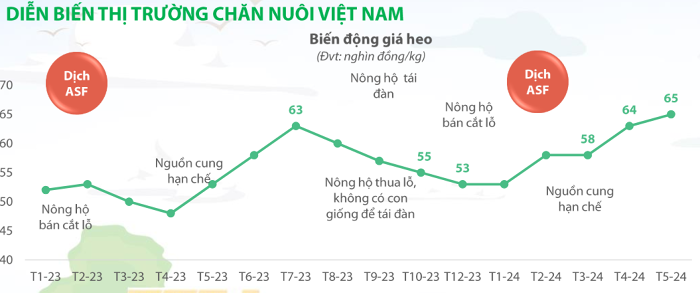According to Mr. Ngo Cao Cuong, Director of BaF Agricultural Finance, live pig prices tend to increase to about 70,000 VND/kg until the end of the second quarter. Currently on the market there are no breeding pigs or weaned pigs to re-herd, so prices are difficult to reduce.
BAF Agriculture Joint Stock Company (Code: BAF) has just had a session to share with investors about the production and business situation in the first quarter. The company representative also forecast that the price of live pigs on the market will continue to increase.
Mr. Ngo Cao Cuong, Chief Financial Officer, said that at present, pig prices are increasing well, if maintained like this, it will increase to about 70,000 VND per kg until the end of the second quarter. The increase in live pig prices is explained by supply. Big livestock farmers in the market are having to import breeding pigs at high costs because of the impact of African swine fever (ASF).
“The number of affected pigs can be up to 1 million pigs due to the epidemic. The characteristic of the epidemic is that if one animal gets sick, the whole farm may have to be canceled if the quarantine is not good. That is why BaF must require very strict quarantine when aware of the danger. If we lose a farm, the capital investment will be huge,” Mr. Cuong shared.
Company representatives commented that even though the price of pigs is high, there is no supply to sell. Farmers or businesses who want to restock their herd need to wait until December to sell, because pigs still have to be raised. Currently, there are no breeding pigs or weaned pigs to restock the herd, so prices are difficult to reduce.
The price of 70,000 VND per kg of live pigs is forecast to be maintained in the second quarter and throughout the year. At the end of the year, the price may decrease to 67,000 – 68,000 VND per kg, but near the Lunar New Year it will increase again to 70,000 VND per kg.

(Source: BaF).
In the first quarter, with prices of 55,000 – 56,000 VND per kg, BaF’s profit margin was positive. However, this target is even wider thanks to the current price of live pigs.
According to the updated CFO, as of May 16, the average price of live pigs nationwide was 64,400 VND/kg, but in some places the highest price was up to 67,000 VND per kg.
Commenting on the overview of the pig farming industry, Mr. Cuong said that the current market trend is causing small households to gradually shrink.
When pig prices are low, people do not have enough capital so they cannot restock their herds, because they have already invested in the previous crop and are affected by the epidemic. Furthermore, if farmers want to raise livestock industrially, they must invest methodically, spending a large amount of money (nearly 200 billion VND) to build biological barns. If you do it yourself, if it doesn’t meet standards, damage from the disease can cause total loss, making it impossible to regenerate the herd, making supply scarce. At this time, industrial livestock farmers own the supply for the market.
On the other hand, there are currently many FDI enterprises that want to sell the livestock sector. Mr. Cuong acknowledged that this group has large capital, if losses can still be compensated from the animal feed segment (Feed). However, it is impossible to avoid gradual competition from organized business groups.
Therefore, on its part, BaF has had to continuously increase the farm scale, accelerating to reach the target of 6 million total herds by 2030 to meet market supply.
Mr. Cuong recalled the story of Muyuan company in China. This is the largest pig slaughter enterprise in the world. 4 – 5 years ago Muyuan’s scale was smaller than BaF now. However, by 2023, this unit will have sold 61 million animals, or 10 times more than BaF if it achieves the 2030 target (6 million animals).
Furthermore, the average consumption per capita is only about 30-33 kg per person per year. But in China, the average consumption figure is 53-55 kg per person per year. Thus, the remaining 20 kg space is very large, and is potential for the livestock industry to develop.
On the other hand, on January 1, 2025, the new Livestock Law will come into effect. This law prohibits the act of raising livestock in areas where livestock farming is not permitted in cities, towns, townships, or residential areas; Regulations on scale, density, and distance of livestock farming according to each region. Accordingly, tens of thousands of livestock facilities across the country had to move out of residential areas or cease operations. According to Mr. Cuong, this means supply will decrease very sharply.
Regarding the production and business situation in the first quarter, BaF has put into operation a cluster of Hai Dang farm (5,000 sows, 60,000 pigs), Tan Chau farm (30,00 pigs), Tam Hung farm (5,000 sows). ). The company also started construction on Tay An Khanh farm (60,000 meat in Tay Ninh), upgrading Tay Ninh bran factory phase 2.
The total herd currently reaches 430,000 pigs, with 1 million commercial pigs. In 2024, BaF expects pig consumption to reach about 610,000 pigs and pig sales to be 3,400 billion VND. The number of farms put into operation in the 2024-2025 period is expected to be 18 farms across the country.
In the first quarter, BaF revenue reached 1,292 billion VND, up 58% over the same period last year; pre-tax profit of 138 billion VND, far surpassing the figure of 4 billion VND in the first quarter of 2023. Revenue structure includes 59% from agricultural products, while livestock accounts for 41%.
Forecast of sales and pig production of BaF. (Source: BaF)
Xuân Nghĩa
VietnamBiz

